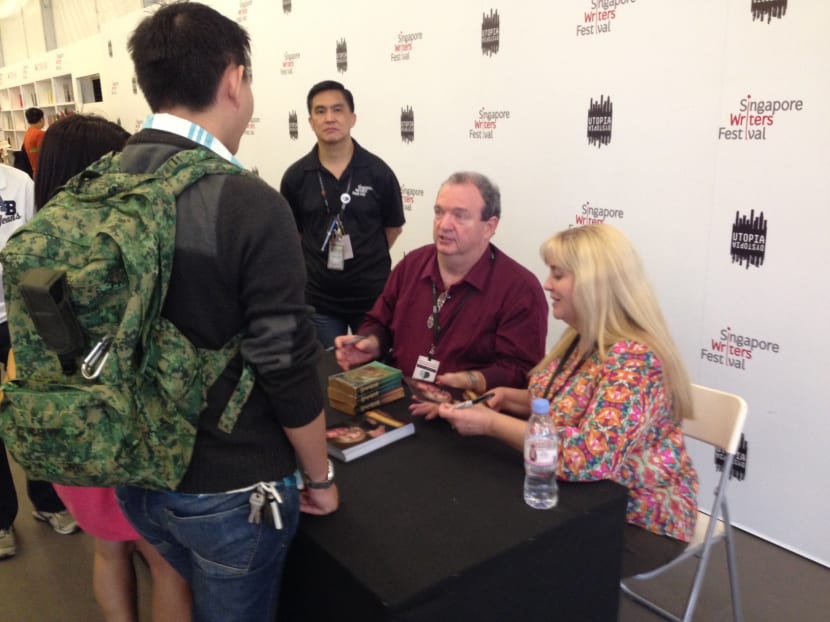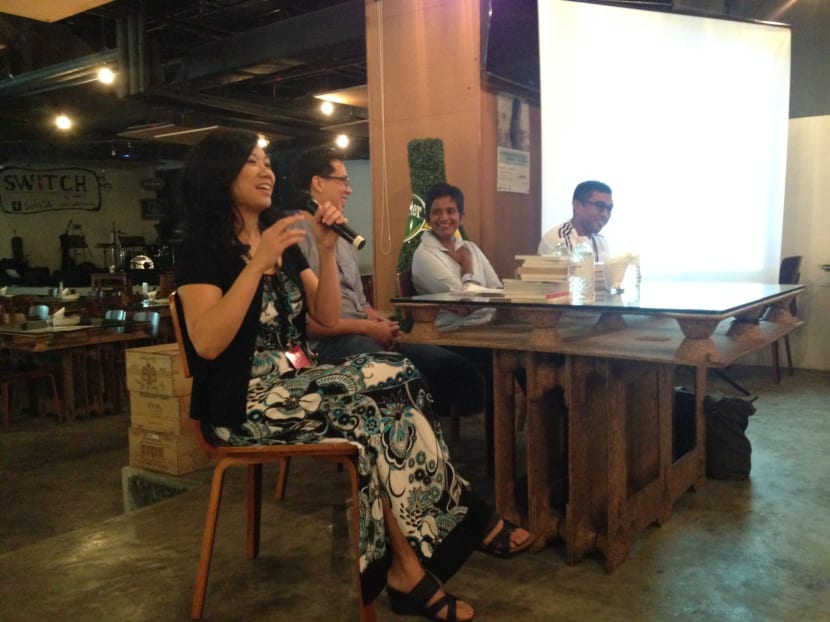S’pore Writers Fest: Dragonlance, DIY and the road less travelled
SINGAPORE — A visit to the SWF on its second-to-the-last day (Saturday) offered a lesson in taking the road less travelled.


SINGAPORE — A visit to the SWF on its second-to-the-last day (Saturday) offered a lesson in taking the road less travelled.
Most evident, of course, at the Been There, Done That session comprising travel writers Lee Siew Hua, Rodney Ee, Hu Wei, and Sim Siong Chye, and moderator Pamela Ho.
From bunking with 50 Catholic nuns to writing an imaginary letter to the Prime Minister of Japan, they sure had a lot of stories to tell. Not to mention this sagely advice from Lee.
“Get off the map.”
***
Which can lead to wonderful things, as was the case with Tracy and Laura Hickman.
The husband-and-wife American fantasy authors lived in Indonesia in 1976 as Christian missionaries, where they picked up the language — and eventually found use for it in the groundbreaking fantasy world they created in 1984 called Dragonlance.
“I speak fluent Indonesian as long as there’s no one around to understand it,” quipped Tracy, at their talk.
It’s not an empty boast when he describes Bahasa Indonesia as having a “fascinating language structure” — he proceeded to elaborate on the different permutations of the rootword “jalan”. Power!
“A lot of words sneak into the family language,” shared Laura, who said they still use words like “asli” or “asam” at home. Where she cooks satay and martabak (or Indonesia’s version of pancakes).
But this Indonesian influence doesn’t just apply to the domestic setting — it has found its way into the Hickmans’ creative work, particularly Dragonlance.
“I kept sneaking Indonesian words into the (magic) spells,” Tracy joked. These insertions were both due to their love of the language and “because it was exotic to gaming designers in Wisconsin”.
Case in point was a place called Neraka in the Dragonlance books. As a kid, of course I didn’t know it was the Indonesian word for “hell” but it sure as, erm, hell sounded cool.
Unfortunately, as Tracy revealed, it can lead to some awkward moments. Such as when a woman contacted them. You see, her parents loved the books so much they named her after that particular place. Oops.
***
Actually, the entire *idea* of Dragonlance came about while they were travelling.
Games developer TSR (of Dungeons & Dragons fame) had just hired them (at that point they were struggling to make ends meet and support their family) and they came up with the entire world on a cross-country drive in the US to their new workplace. (I guess, a cross-country drive in Singapore can result in something less like an entire world and more like a village.)
Dragonlance was initially a “stop gap” in the TSR scheme of things until the next big gaming idea came about. That never came because, well, Dragonlance was *the* next big thing — propelled by the books (Dragonlance Chronicles and Dragonlance Legends, which Tracy wrote with frequent collaborator Margaret Weis).
To think that the books were just one of many merch options to supplement the games. Other proposals were miniatures, beach towels and needlepoint products.
“Needlepoint on the wall with magic spells is just not right,” deadpanned Tracy, who recalled that TSR didn’t know what to do with the books at first.
But at the same time, the working environment was similar to the experimental working environments of the early dotcom pioneers or even Facebook today.
“The creative atmosphere was open and pretty easygoing. You could make stuff up — and that’s your job,” said Laura.
Being creative, and thinking up of stories with dragons and elves and dwarves, didn’t mean slacking, however.
If JRR Tolkien created Middle-Earth through meticulously invented language, the Hickmans created Dragonlance through meticulously invented geography and topography.
They started with a continent. Then imagined coastal currents. Then imagined the tectonic plates so that they could imagine where the mountains would be, then the rivers — and only then did they come up with a 3,000 year old civilisation.
After which, Tracy said, he dropped the proverbial meteor to wipe out everything and start all over again.
Yes, he created and destroyed all that just so his stories can have a *sense* of history and place.
There’s a lesson to be learned here, not just for writers but any creative mind, I guess. The willingness to let go and destroy for the sake of discovering the new.
But there was a sad bit of detail during the talk too. Next year marks the 30th anniversary of Dragonlance, and Tracy’s already got an idea for a brand new trilogy revisiting the characters of the books. But he can’t do it just yet because the intellectual property rights to the characters don’t belong to them but to the company (now it’s Hasbro).
***
IP was one of the issues discussed by another panel comprising of folks who, like the Hickmans, have taken the road less travelled.
Shamini Flint, Don Bosco, Eliza Teoh are all self-published authors, and their DIY philosophy has resulted in the Sasha, Sherlock Hong/Ghostly, Ellie Belly children’s book series, respectively.
Judging by the pretty impressive crowd at Switch, self-publishing seems like something a lot of people (including budding writers) are seriously considering.
If you’ve just noticed, the three authors are all into mostly children’s books — where self-publishing on a local scale seems to work. Indeed, Teoh pointed out that the bigger, conventional publishers weren’t at all interested when she presented her Ellie Belly idea to them.
Having a niche product is a good reason to self-publish, agreed Flint. But she also added that there’s really no reason to turn one’s back on conventional publishers. (Her Inspector Singh crime novels aren’t self-published.)
There are some pros in going the traditional route, she said. The luxury to simply just write and leave everything else (marketing, printing, distributing) to the publisher. Not to mention the possibility of translations, serialising and even movie options.
Or, simply, cred, aka “official-therefore-this-book-is-not-s**t”, as Flint quipped.
But, of course, there’s the issue of IP. Teoh pointed out that most traditional publishers own the IP rights to your works, whereas in the world of self-publishing, you own everything and are free to do whatever you want with whatever you’ve written.
That said, Flint pointed out that while self-publishing is a good start, taking it to the next level — going bigger, going international — could be a problem.
So how do you do it then?
See what’s selling but don’t lose your voice, said Teoh/Flint. But it’s Bosco who’s got the most awesome — and practical — tips.
From simply trying to put an ebook online (via Smashwords) for 24 hours to see how it feels to trying out the pre-order strategy (basically a kind of crowdfunding) with a demo book (via on-demand printers ACCEA), he was quite detailed and very helpful and encouraging about it too. After all, in the self-publishing world, he said, “hospitality” is the way to go.
The Singapore Writers Festival 2013 ends today. Check out the buzz on the local arts scene at http://www.todayonline.com/artlanders.








